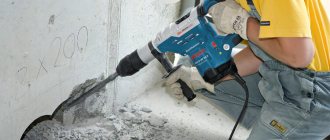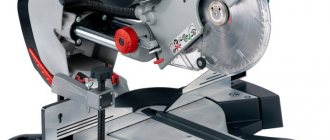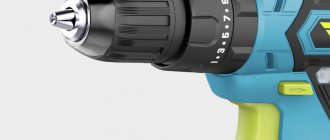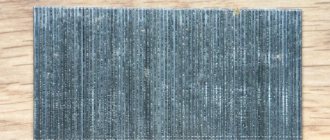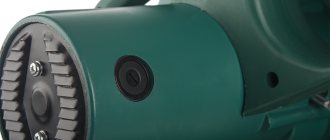It’s hard to imagine a modern major renovation of an apartment or private house without the use of a wall chaser. After all, without this tool it is impossible to cope with such a difficult task as laying wiring and pipes. Fortunately, the modern market is filled with a variety of models, and among them there are both expensive and very budget options. True, choosing a quality wall chaser is still not always easy. If only because even an experienced user, not to mention a beginner, can get lost in the numerous characteristics. It is for this case that our experts have compiled the TOP of the most successful models. Since the rating includes the best wall chasers based on customer reviews and independent expert assessments, it is truly objective and will certainly help readers choose the most suitable tool.
Cutting depth, groove width, blade diameter
All these three parameters are closely interrelated, because they determine the specifics of using a furrow machine. As for the disc diameter, it can be from 100 to 355 mm. The depth of cut directly depends on the diameter. For an electrician, it is enough to choose a wall chaser with a 150 mm disc, which can make a wall 45 mm deep, which is enough for laying electrical wiring even in corrugated areas. A 180 mm disc allows you to penetrate a wall to a depth of up to 60 mm, which is the optimal indicator if you want to lay other utilities in a hidden way (water, gas, etc.). A 230 mm disc allows you to make a groove of 85 mm, but note that the minimum depth due to the design of the tool is from 15 to 20 mm.
As for the groove width, it is adjustable and varies from 6 to 60 mm. For electricians, it is enough to choose a wall chaser with a cutting width of up to 30 mm. We advise builders to choose slightly higher specifications so that they can cut a groove for pipes without any problems.
Weight and size
At first glance, the purpose of wall chasers is the same, but there are significant differences in their use.
After all, cutting grooves on the ceiling with a ten-kilogram tool is not an easy task. At the same time, a heavy and powerful tool will greatly reduce the time when cutting grooves on concrete floors or walls.If you are professionally engaged in work related to gating, then ideally it is good to have two wall chasers - light, but less powerful and heavy.
For universal home use, the best option is recommended - up to 6 kilograms. Some craftsmen make light wall chasers from grinders.
How to make a transformer with your own hands - step-by-step instructions, diagram, drawings, list of materials + photo of a finished homemade transformerWhich hidden wiring detector is better? TOP 10 best manufacturers with photos and descriptions
Technological maps in construction - what is it?
Assembly tips, as well as videos and photos of a DIY wall chaser, can be found on the Internet.
Design features
The first thing you need to decide is how many cutting discs the wall chaser should be designed for. If you are only engaged in gating walls for wiring and laying pipes, it is enough to choose a tool with 2 disks, which allows you to make an even groove. A furrower with one disc allows you not only to groove walls, but also to do cutting work (cutting stone, metal and concrete).
Please note an important point - removing the second disc in order to cut stone or concrete is not allowed, so you will not be able to “kill two birds with one stone.”
Secondary functions
Additional functions that some models may be equipped with make work easier and more comfortable. For example, the speed control function ensures that tool performance is maintained at the same level throughout the entire work process.
Anti-jamming of the disc protects against injury. Overheating protection increases the service life of the device and protects it from serious damage.
Some models may have protection against accidental activation and the possibility of parallel use of a vacuum cleaner, which ensures dust-free operation.
There are also models that provide a function for controlling the production of brushes, the ability to regulate engine speed, etc. Additional features increase the cost of the tool.
Operating rules
Preparatory stage
- Before connecting the device to the network, you need to find out whether the power of the furrower cable matches the electrical wiring. If the performance of the tool exceeds the capabilities of the power point, then during operation it will periodically turn off or break. Another risk of such a connection is a short circuit in the electrical wiring.
- There should be no flammable objects in the work area. Sparks emanating from the cutting element are ready to start a fire.
- In the room where the wall chaser is used, it is necessary to organize good ventilation. This will help avoid the accumulation of a large layer of dust inside the instrument.
- The master who forms communication channels must use security measures. They reduce the likelihood of injury. Used: glasses, face shield, headphones or earplugs, construction respirator. Maximum protection is provided by a shield made of polymer material, which cuts off sparks emanating from the cutting element.
- Before the first connection, you should check the integrity of the cable and components.
- When installing the cutting part, set the immersion depth. Experts recommend setting a value that exceeds the required value by 1-2 mm. This makes it easier for the wall chaser to pass along the working surface.
During operation
- Often, when making a groove, the saw blade gets stuck in concrete (or other material). To remove the cutting part, you should unplug the tool and only then, using various maneuvers, try to free the disk. In the connected state, a traumatic situation is possible due to the sharp kickback of the wall chaser. There is also a risk of device failure.
- It is better to groove the surface from top to bottom so that the direction of the disk is always under observation.
- As consumables wear out, they are replaced.
Rules of care
- Upon completion of work, you need to clean the ventilation holes in the housing from dust and other contaminants.
- Worn parts must not be used for work. When replacing them, give preference to parts from the same manufacturer as the wall chaser itself.
- It is not recommended to use aggressive chemicals to clean the body. They can damage the plastic. When using a soap solution, avoid getting any liquid inside the instrument. This may cause a short circuit or fire.
Important Details
The equipment of different types of tools and manufacturers of wall chasers differs. If you choose a model with a vacuum cleaner, make sure that the hose will not interfere with your work.
- How to fix a laptop that won't charge
Insulated dielectric screwdrivers up to 1000V - tips on how to choose the best manufacturer
Dielectric insulated tool for work - which one is better to choose? Review of manufacturers, photos + video
Some models are equipped with a chisel, which is convenient for cleaning the groove.
Pay attention to the length of the electrical wire.
When checking the device, take into account the noise of its operation and the smoothness of the cut adjustment. The tool should fit comfortably in your hand.
The best wall chaser
A wall chaser is used when you need to quickly cut a groove for laying a thin wire. The presence of one cutting element speeds up the process, but a thick cable cannot be inserted into the groove. In this case, you will need to make a second cut, which will take twice as long, and its evenness will be far from ideal.
Makita 4112HS
The furrowmaker is assembled in Japan and the manufacturer has provided it with a power of 2400 W. Designed to work with very large discs with a diameter of 305 mm.
Advantages
- It starts smoothly and gradually picks up speed.
- Comes with a convenient suitcase and a wrench for unscrewing the shaft.
- Rapid rotation of the disc at a speed of 5000 rpm.
- One of the largest cutting depths is 100 mm (you can even cut out a small window in a brick partition).
- The wide start key is convenient for pressing with all fingers, and not just one, which quickly gets tired.
- Insulation with double protective layer.
Flaws
- A weight of more than 10 kg greatly tires your hands.
- Does not maintain constant speed - the rotation speed depends on the density of the material.
- Another scheme of work (without rolling on support rollers), but by immersing the saw blade, therefore it is performed much slower than conventional wall chasers.
Conclusion. This is a good wall chaser for laying low-current systems (telephone line, Internet, antenna cable, alarm system). With one disk you can make a thin groove for inserting a small-section wire.
Manufacturers
You always want to buy a tool inexpensively, but so that it is trouble-free in operation and lasts a long time. Today, on the shelves of electrical stores there is a large selection of power tools from Russian manufacturers, the price and quality of which are quite acceptable.
Among the domestic models, your choice can be “Interskol”, “Fiolent”, “Zubr”. The products of the Bulgarian and South Korean “Keyang” have proven themselves well.
In this list it is impossible not to mention such giants and world leaders in the production of electrical equipment as German, Kress, Metabo; Japanese "Makita" and "Hitachi".
This article touches on the most important points that you need to pay attention to when choosing a wall chaser. This information is enough to know what you should pay special attention to when purchasing, and what questions to ask your sales consultant.
Good specialists work in the electrical engineering departments; their advice will also help you make the right choice when purchasing.
FIOLENT B1-30 – inexpensive for household use
Affordable and equipped with a moderately powerful engine, the furrower can cope with brick and aerated concrete masonry and lay a groove in a concrete screed. By changing the cutting equipment, the tool will saw metal workpieces. The design provides for the operation of the wall chaser as an angle grinder. The tool is distinguished by its simple operation. The two-position attachment of the additional handle makes work easier.
PROS
- Long supply electrical cable.
- Price for such power and technical capabilities.
- An effective system for collecting and eliminating cutting products.
MINUSES
- The location of the gearbox greatly complicates the cutting process.
- There is not enough strength for serious work on concrete structures.
Photo tips on how to choose a wall chaser
Did you like the article? Share

0
GROST M2535 – equipped with concrete blades
A highly effective specialized tool for working on many types of stone-like materials. The difference from disk analogues is that the cut is made with special knives equipped with carbide brazing. The material is removed in one pass; the process ensures complete removal of the cut material. The cutting tool is restored - just remove the knives and sharpen them.
PROS
- High productivity due to the elimination of additional operations for removing material.
- Optimal power for working on brick and concrete screed.
- Restored performance of cutting knives.
MINUSES
- The narrow specialization of the tool is only for turning grooves.
- Difficult to overcome dense types of concrete.
Principle of operation
A wall chaser, or otherwise known as a furrow cutter, is a tool with an electric motor, equipped with two replaceable diamond discs for cutting concrete. This distinguishes it favorably from angle grinders and wall cutters when making channels in walls. Where an angle grinder needs two passes, a wall chaser needs one. In this case, the discs are cut strictly in parallel. Therefore, the edges of the channel are smooth, the width is the same throughout.
Another difference from an angle grinder is the presence of adjustment of the depth of cut. On a wall chaser, it is set before starting work and remains until it is completed. When sawing a wall with a grinder, the operator himself has to monitor the depth of the cut.
Diamond blades are not included, although there are rare exceptions. They are purchased independently. When choosing, the material to be cut is taken into account: concrete, expanded clay concrete, brick. Professional craftsmen pay attention to the disk resource. Reputable manufacturers state it at the level of 20-30 m².


